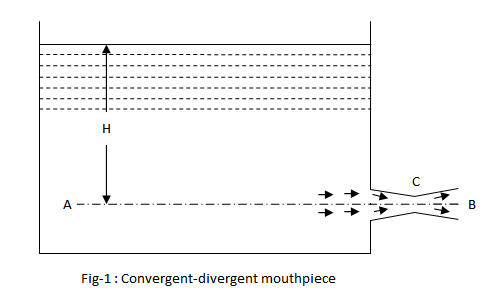Convergent_Divergent Mouthpiece
Discharge and Pressure in a Convergent - Divergent Mouthpiece
Contents
Discharge Through A Convergent-divergent Mouthpiece
The discharge through a convergent-divergent mouthpiece is same as convergent mouthpiece. In such a mouthpiece, there will be no loss of head due to sudden expansion. The coefficient of discharge Cd in the case of convergent-divergent mouthpiece is also 1. The diameter of the mouthpiece, for the purpose of calculating the discharge, is taken at the vena-contracta i.e., at C (or in other words where the convergent and divergent pieces meet). It is also known as throat diameter of the mouthpiece.Example:
[metric]
Example - Discharge through a Convergent - Divergent Mouthpiece
Problem
A convergent-divergent mouthpiece having 80mm throat diameter is discharging water under a constant head of 4.5m. Find the discharge through the mouthpiece.
Workings
Given,
^2&space;=&space;\frac{\pi}{4}&space;\times&space;(0.08)^2&space;=&space;5.027\times&space;10^{-3}\;m^2) and discharge through the mouthpiece,
and discharge through the mouthpiece,

\times&space;\sqrt&space;{2\times&space;9.81\times&space;4.5}\;m^3/s)

= 4.5m
= 80mm = 0.08m
Solution
Discharge through the mouthpiece = 47.2 liters/s
Pressure In A Convergent-divergent Mouthpiece
Consider a vessel open to atmosphere at its top, having an orifice fitted with a convergent-divergent mouthpiece as shown in fig-2. We know that the slope of the mouthpiece is the same as that of the jet up to vena contracta, and beyond that is it made divergent. The theoretical absolute pressure head at vena contracta is the same as that of atmospheric pressure head.
= Atmospheric pressure head
= Height of liquid above the mouthpiece
= Absolute pressure head at vena contracta
= Velocity of liquid at outlet
= Velocity of liquid at vena contracta
= Area of mouthpiece at vena contracta
= Area of mouthpiece at outlet
Example:
[metric]
Example - Pressure in a Convergent - Divergent Mouthpiece
Problem
Water flows through a convergent-divergent mouthpiece of diameter at convergence 40mm, under a head of 4m. Determine the maximum diameter of divergence to avoid separation of the flow, if the maximum vacuum pressure is 8m of water.
Workings
Given,
 = Maximum diameter of the divergence in meters
We know that,
= Maximum diameter of the divergence in meters
We know that,




= 40mm = 0.04m
= 4m
- Maximum vacuum pressure head
= 8m
Solution
Maximum diameter of the divergence, d = 52.6mm
 Login
Login


